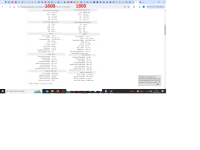Hi,T/S parameters usually are all over the place, they very dependent on measuring methods and measuring levels, driver condition etc.
Here is an example of level dependency, JBL 2216Nd, measured at lower and higher input levels. This driver is like came from the marriage of a PA and a hi-fi woofer so not represents a full-blown PA woofer like the Faital 18XL1600 but the change of the parameters are clear. I saw a similar measurement of a typical 18" PA woofer with very stiff suspension where the Fs dropped from mid 30s to low 20s at high level input.
View attachment 1339270
I plugged these into VituixCAD enclosure tool and there is some differences in alignment between small and large signal measured TS parameters, but nothing dramatic, db or two differences. So, with small signal params there is "less lows", and when more SPL so that Cms and some other parameters change, there is little bit more of bass but difference in this data isn't that much. Anyone have more this kind of datasets to test? To me it seems equal loudness curves are much more dramatic than differences here with this data.
The changing parameters seem to have more effect on huge sealed box than on a tiny one.
300l box
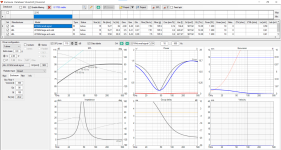
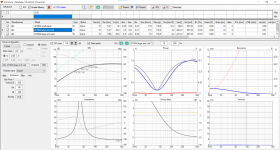
30l box
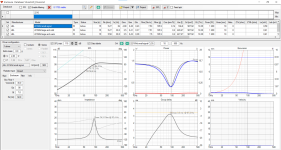
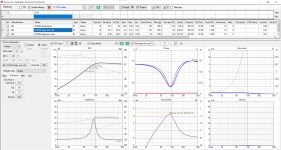
Same trend seems to be with ported box, differences about the same magnitude, bigger box seems to have more than small, with quick testing.
With this quick test I'm not sure how much surround softening actually happens and matters, again perhaps on some drivers it is worse than here, although Cms changes here almost 50% it doesn't make much of a difference in simulator.
ps. the TS params for 2216Nd are from YSDR post #87. I could not find power rating or xmax for the driver so used 1200W (from M2 datasheet) and just questimated the xmax. These do not affect the simulation though.
Last edited:
Maybe the combination of the Faital with the "almost-no-Vd-Audax" is the reason for the skinny sound. Do you intend to use someting between them ? Or will the Peerlesses stay ?The 18 Faithal perceived almost never to "hold togheter" the soundimage, and sounds "skinny" and a little "strange" up to about 100 dB, from there it plays "better" (but that is a definition).
But the Faithal don´t fill "the floor" with bass until real high SPL, and when it does it´s more of a "party-sound" ( hard to explain)
Regards
Charles
Btw, one could test any driver by editing Cms (or any other TS param) in Vcad. Put VAS to 0 so the program calculates new value for it.
Looks like this alone doesn't make much of a difference in sim, perhaps Fs, Qms and Qts would also need new values for more difference.
Here 18XL1800 with original TS params with auto aligned SBB4 reflex box, and then Cms increased 50%, difference is practically non-existent.
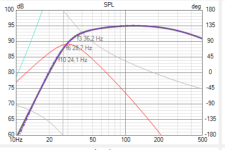
edit. Cms doubled from 0.11 to 0.22 and difference still pretty much negligible. Same if cut in half, differences roughly 1db here and there, at least with this particular driver and alignment.
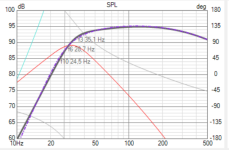
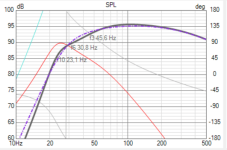
Looks like this alone doesn't make much of a difference in sim, perhaps Fs, Qms and Qts would also need new values for more difference.
Here 18XL1800 with original TS params with auto aligned SBB4 reflex box, and then Cms increased 50%, difference is practically non-existent.

edit. Cms doubled from 0.11 to 0.22 and difference still pretty much negligible. Same if cut in half, differences roughly 1db here and there, at least with this particular driver and alignment.


Last edited:
But this woofer is very good/stable because its parameters doesn't change much at low vs high input. The 18" woofer parameters that I mentioned changed much more. I try to find that test.the TS params for 2216Nd
Found another thread where someone changed surround and reports audible difference.
https://www.diyaudio.com/community/threads/thiele-small-parameters-question-cms-fs.227368/
There is also the basic formulae that link these parameters. If you don't find the measurements we could just calculate some and virtually loosen the suspension. Fs, Rms, Qes, Qms and Qts can be calculated from any/changed Cms
Formulae in Wikipedia
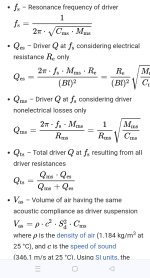
edit. on VituixCAD Vas, Fs, Qes, Qms and Qts can be set to zero, then change Cms and save the driver and these are filled in. Change in Rms needs to be guessed though... seems to be quite small change in Rms compared to Cms on the 2216Nd so either the magic is in the Rms, or it doesn't matter too much. Didn't experiment with this stuff yet, gonna do it now 🙂
https://www.diyaudio.com/community/threads/thiele-small-parameters-question-cms-fs.227368/
There is also the basic formulae that link these parameters. If you don't find the measurements we could just calculate some and virtually loosen the suspension. Fs, Rms, Qes, Qms and Qts can be calculated from any/changed Cms
Formulae in Wikipedia

edit. on VituixCAD Vas, Fs, Qes, Qms and Qts can be set to zero, then change Cms and save the driver and these are filled in. Change in Rms needs to be guessed though... seems to be quite small change in Rms compared to Cms on the 2216Nd so either the magic is in the Rms, or it doesn't matter too much. Didn't experiment with this stuff yet, gonna do it now 🙂
Last edited:
4 pieces Audax hm210z10 (8 inch mids), push out lots of good sound with their 99 dB sensivty.Maybe the combination of the Faital with the "almost-no-Vd-Audax" is the reason for the skinny sound. Do you intend to use someting between them ? Or will the Peerlesses stay ?
I use them from 340 hz, but in the test also from 280-300 hz.
So the 18XL1600 was playing upp to the mids. (maby to high i know)
The 6 Peerlees 12 inch is real hard to beat with their +- 12,5 mm linjear xmax and 92 db sensivty.
And no problem up to 340 hz ( so the +- 1,5 mm Audax don´t broke)
And just this type of 18 inch woofer, suits better as a cinema-sub up to 100-120 hz or as PA-concert´s speaker.
It is really brutal in every way.
regards John
Did some experiments yesterday but didn't have time to post.
I played around 18XL1800 😀 sorry, could have used the xl1600, some brain fart.. anyway, similar driver, similar results*.
So, added same driver three times, one with datasheet specs and the other two with stiff and loose suspension, either doubling or halving the Cms. Put Fs, Qes, Qms, Qts and Vas to zero and change Cms and VituixCAD calculates the missing values. One could change Rms as well, although it's value has very little effect on the sims. Doubling / halving the Cms seems to change Fs roughly 10Hz, something YSDR mentioned he has seen in worst case.

Now it is easy to experiment with different sized boxes and just swap the driver in the simulator to see what if the suspension was more or less stiff. This would not show any distortion or dynamic effects such phenomenon might have. Still, quite small changes in alignment suggests they likely aren't that significant. Of course this is just me simulating and interpreting so if you know better please comment. Some data would be nice 🙂
Here again, a box autoaligned with datasheet TS spec and the curves represent all three variations of stiffness.
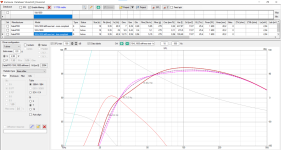
If box is made with datasheet TS values, both the stiff and loose version seem to get similarly fine results as the datasheet spec. As per observations so far the datasheet parameters are likely with loosened suspension so that fresh cold driver would likely measure bit more stiff so see the worst graph initially. Now one would do "burn in" to loosen it up, or if it is a driver like Jawen suggests that sound changes when there is sufficient SPL output. Alright, sound could change some, for better.
If a box simulation was made with the cold measured stiff TS params it would look kinda bad.
Here autoaligned box with the very stiff setting. Again, all three drivers as overlays so not much difference, but the box is just bad.
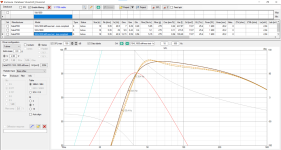
For completeness, autoaligned box with loose surround. Again not too much difference between all the three variations.
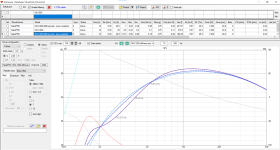
These tests indicate to me that it is good plan to design box with datasheet TS values, if one is not competent to know better. If surround is stiff TS parameters would measure different than in datasheet but the response wouldn't be that much different in same box, and would likely get better in time, or with louder output level.
* Btw. Loudspeaker database has updated their GUI since last visit and it has great visualization on the filters to do experiments like this, fun and easy to find stiff drivers to do tests. Unfortunately I didn't see VituixCAD copy/paste stuff there anymore...
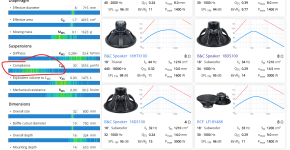
I played around 18XL1800 😀 sorry, could have used the xl1600, some brain fart.. anyway, similar driver, similar results*.
So, added same driver three times, one with datasheet specs and the other two with stiff and loose suspension, either doubling or halving the Cms. Put Fs, Qes, Qms, Qts and Vas to zero and change Cms and VituixCAD calculates the missing values. One could change Rms as well, although it's value has very little effect on the sims. Doubling / halving the Cms seems to change Fs roughly 10Hz, something YSDR mentioned he has seen in worst case.

Now it is easy to experiment with different sized boxes and just swap the driver in the simulator to see what if the suspension was more or less stiff. This would not show any distortion or dynamic effects such phenomenon might have. Still, quite small changes in alignment suggests they likely aren't that significant. Of course this is just me simulating and interpreting so if you know better please comment. Some data would be nice 🙂
Here again, a box autoaligned with datasheet TS spec and the curves represent all three variations of stiffness.

If box is made with datasheet TS values, both the stiff and loose version seem to get similarly fine results as the datasheet spec. As per observations so far the datasheet parameters are likely with loosened suspension so that fresh cold driver would likely measure bit more stiff so see the worst graph initially. Now one would do "burn in" to loosen it up, or if it is a driver like Jawen suggests that sound changes when there is sufficient SPL output. Alright, sound could change some, for better.
If a box simulation was made with the cold measured stiff TS params it would look kinda bad.
Here autoaligned box with the very stiff setting. Again, all three drivers as overlays so not much difference, but the box is just bad.

For completeness, autoaligned box with loose surround. Again not too much difference between all the three variations.

These tests indicate to me that it is good plan to design box with datasheet TS values, if one is not competent to know better. If surround is stiff TS parameters would measure different than in datasheet but the response wouldn't be that much different in same box, and would likely get better in time, or with louder output level.
* Btw. Loudspeaker database has updated their GUI since last visit and it has great visualization on the filters to do experiments like this, fun and easy to find stiff drivers to do tests. Unfortunately I didn't see VituixCAD copy/paste stuff there anymore...

Last edited:
Hi,
here XL1600
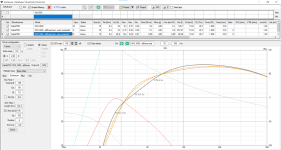
And as bonus megastiff 18DS100
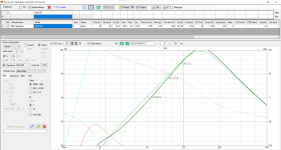
Differences roughly 1db as with the other examples I posted, and tried. These are quite fast to test on your own, slow to post 🙂
I'm doing this in hope we get some measured data or more experiences here, what the differences might be in reality. Eventually it's the perception that matters, so I must conduct some tests on my own.
here XL1600

And as bonus megastiff 18DS100

Differences roughly 1db as with the other examples I posted, and tried. These are quite fast to test on your own, slow to post 🙂
I'm doing this in hope we get some measured data or more experiences here, what the differences might be in reality. Eventually it's the perception that matters, so I must conduct some tests on my own.
- Home
- Loudspeakers
- Multi-Way
- How small box can an Faital Pro 18XL1600 work good in?
